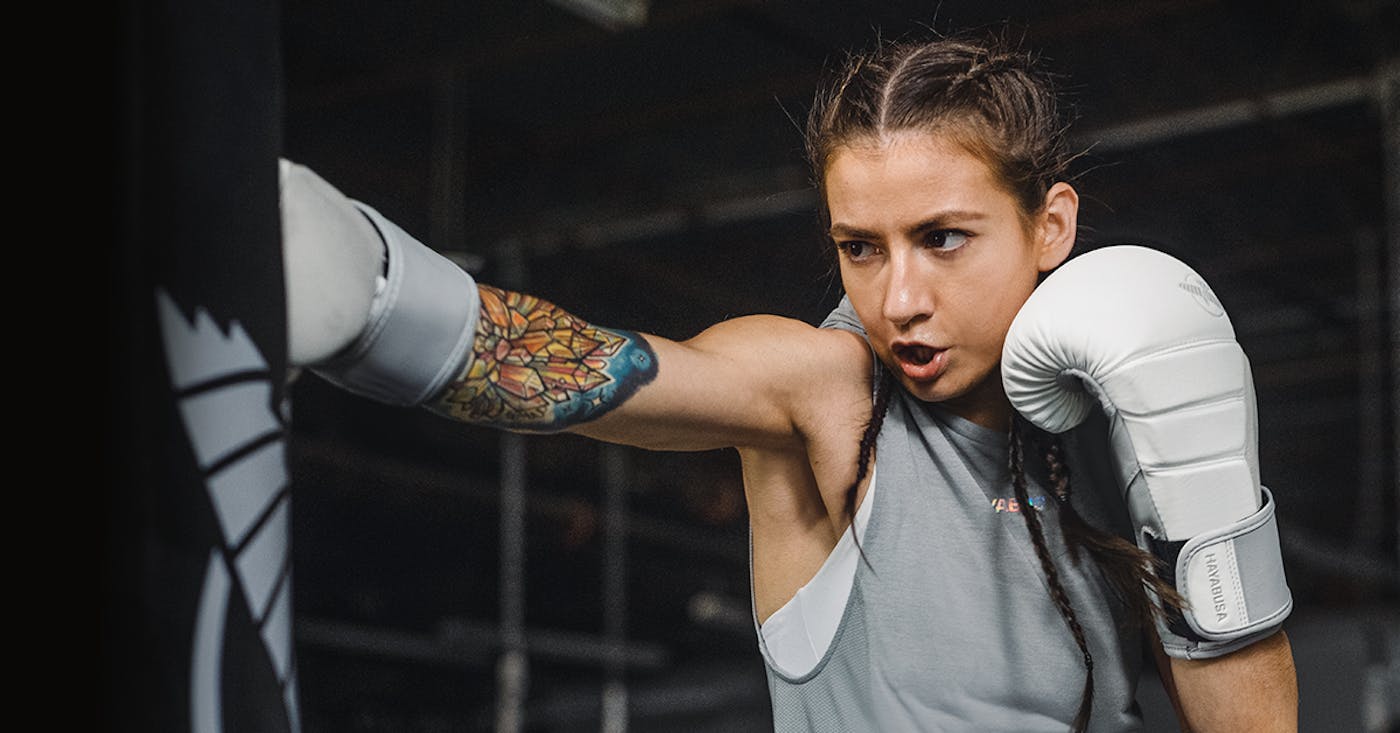TL;DR: Stamina vs. Endurance – What's the Difference?
Stamina refers to how long you can perform at your maximum effort without fatigue, while endurance is about sustaining an activity over a longer period. Stamina is crucial for short bursts of intense energy, like sprinting, while endurance focuses on maintaining performance for extended activities, like marathon running. Both are key to fitness, but stamina measures your peak energy output, and endurance measures how long you can sustain it. This guide breaks down the differences between stamina and endurance and shares exercises to build both.
Stamina vs. Endurance: What’s the Difference & How to Build Both
Stamina and endurance are often thought of as one and the same, and it’s easy to understand why: Both refer to maximum performance, and both are crucial to peak fitness, inside and outside of the gym or ring.
But there are key distinctions between the two, and gaining a solid grasp on each can assist you in crafting a regimen that will help you meet your training goals.
Read this guide as we unpack the endurance vs. stamina question and provide guidance on elevating both to bolster your training.
What is Stamina? Understanding Short-Term Peak Performance
So, what is stamina? Stamina is the amount of time you can perform a task at or near your maximum limit without fatigue, distraction, or a loss of quality. It doesn’t matter if you’re sparring or completing a set of pushups.
What is Endurance? Sustaining Long-Term Physical Activity
On the other hand, endurance describes the maximum amount of time you can perform an activity.
In simple terms, the focus of endurance is less on the energy put forth to execute a task powerfully or adeptly and more on how long you can sustain it. How long your endurance lasts depends on stamina, but unlike stamina, it’s one of the five elements of physical fitness.
No matter if it’s hitting the last 30 seconds in the 12th round or swimming laps, endurance comes down to:
- Muscle endurance – Muscular endurance is characterized by how long your muscle strength can be sustained while exercising.
- Cardiovascular endurance – This is defined by the duration your heart, blood vessels, and lungs can fuel your workout without tiring out.

Stamina vs. Endurance: Key Differences Explained
To better distinguish stamina and endurance, consider running as an example:
- A sprinter is noted for their running stamina because they call upon brief but hyper-potent bursts of energy to give a short run their all.
- A marathon runner, in comparison, may have excellent running endurance because of the overall time and distance they cover. They may be more judicious with their energy to sustain themselves from start to finish.
With this comparison in mind, when it comes to fitness, physical stamina is the full capacity of energy you can summon from your muscles, while endurance is the maximum amount of oxygen you can mobilize for a specific activity. It’s a matter of intensity versus duration—or strength versus staying power.
How to Build Stamina: Top Exercises for Peak Performance
Exercises that zero-in on promoting physical stamina and endurance can lead to various benefits, from improving your immune health to easing the aging process. They can also help you take your training game or aerobic exercise to whole new heights.
How to Build Stamina
Stamina facilitates the use of your muscles at their highest capacity. Your movements will be quicker, your technique sharper, and your form stronger. Weave these best exercises into your training program, and you might find that you have more vigor in general:
Plank: Strengthening Core and Increasing Stamina
Planking is a cornerstone of most workout routines because it works. Not only does it help you perfect your posture and hone your form, but it also enhances stamina by conditioning your muscles to withstand stress for a prolonged period.
In addition, planking strengthens your core muscles, including your:
- Obliques
- Abs
- Pelvic floor
- Back extensors
Need a refresher on how to do a plank? Follow these instructions for a good workout session:
- Get into the start of a push-up position with your hands pressed firmly into the floor and your arms straight.
- Ensure your spine is straight and your core is engaged.
- Hold for your desired amount of time, and continue building on it.
Heavy Bag Punches: Enhancing Strength and Power
Punching a heavy bag doesn’t just enrich your eye-hand coordination, they foster balance and help you blow off steam. The bag's weight also challenges your muscles and forces them to work harder, which can improve their ability to manage exertion and increase your full-body strength and stamina. The repetition can also teach you how to strengthen your wrists.
Don’t have a bag in your training equipment? Shadowboxing can also boost heart health, which is foundational to stamina.

How to Build Endurance: Improve Your Staying Power
Endurance furnishes you with the ability to, well, endure. You can run longer, cycle longer, practice Jiu-Jitsu longer—you name it. The importance of endurance training should be on its two primary components: muscular endurance and cardiovascular endurance.
Tabata: High-Intensity Interval Training for Endurance
The idea of endurance training might have you imagining longer or more frequent workouts. While this can certainly work, research demonstrates that high-intensity interval training (HIIT) can be twice as valuable at cultivating endurance as running or cycling.
Tabata is a form of HIIT that consists of 20 seconds of high-intensity exercise followed by 10 seconds of rest; this is repeated throughout the duration of your workout. Classes are widely available at gyms and online, or you can create your own with a mix of strength and cardio training or both. For example:
- 20 seconds jump squats
- 10 seconds rest
- 20 seconds shadowboxing
- 10 seconds rest
Repeat three to four times before moving on to your next series of exercises.
Plyometric Training: Boosting Cardiovascular and Muscular Endurance
Plyometric training—or jump training, as it’s colloquially called—refers to energetic bursts of cardio that may bolster endurance. In fact, a study found that marathoners who brought plyometric exercises into their training programs utilized less energy during their runs than runners who relied on weight training. Give these exercises a try:
Burpees – Burpees tend to elicit one of two responses: Groans or applause. Either way:
- Start in a squatting position and jump into the plank.
- Perform a push-up at the bottom of your plank.
- Jump towards your hands, landing in a squat.
- Jump up again and raise your arms high. Repeat.
Stairway hops – Stairway hops foster cardiovascular endurance and may encourage bone health. Here’s how to perform them:
- Begin at the bottom of a staircase.
- Hop to the top on your right foot.
- Walk to the bottom.
- Hop to the top on your left foot. Repeat.
Stamina and Endurance Training in Combat Sports: Building a Fighter’s Gas Tank
In combat sports, having a powerful gas tank is crucial for sustaining performance through multiple rounds of high-intensity action. Fighters need a perfect blend of stamina and endurance to handle the physical demands of striking, grappling, and defensive maneuvers over prolonged periods without losing their edge.
Examples of Combat Athletes and Their Gas Tanks
Combat athletes like Conor McGregor, Khabib Nurmagomedov, and Israel Adesanya are known for their well-rounded stamina and endurance training. These fighters understand that their gas tank—a term used to describe how long an athlete can perform at a high level without tiring out—is often what separates champions from contenders.
For instance, Khabib Nurmagomedov famously relied on his exceptional cardiovascular endurance to outlast opponents with relentless pressure, maintaining high levels of output through every round. His grappling style demanded a great deal of muscle endurance, as he continuously worked to secure takedowns and control his opponents on the ground.
Meanwhile, Conor McGregor learned the hard way in his earlier career that despite his explosive power and speed, lacking in endurance could result in gassing out during the later rounds. This led him to incorporate more endurance training to better handle extended fights, which he showed improvements in during his rematch against Nate Diaz.
Boost Your Stamina and Endurance with Hayabusa Boxing
Stamina and Endurance Workouts for Combat Sports
Combat athletes often employ a combination of stamina and endurance workouts to build a complete gas tank. Here are some examples of training that fighters use to improve both:
Stamina Training:
- High-Intensity Interval Training (HIIT): Fighters like Adesanya and McGregor use HIIT workouts to boost stamina, focusing on short, explosive bursts of maximum effort with minimal rest in between.
- Heavy Bag Drills: Punching heavy bags for rounds on end enhances stamina by conditioning the arms, shoulders, and core to perform repeated high-intensity strikes without tiring.
Endurance Training:
- Roadwork (Long-Distance Running): Kamaru Usman and Tony Ferguson incorporate long-distance runs into their routine, which is a traditional way to build cardiovascular endurance and maintain energy through five-round fights.
- Swimming and Cycling: Many fighters, including Tyson Fury, use swimming and cycling as low-impact ways to build cardiovascular endurance without putting additional strain on their joints.
Building a Fighter’s Gas Tank: Why It’s Key to Success
A fighter’s gas tank is often the determining factor in championship rounds. As fighters push through the later stages of a match, when physical exhaustion sets in, those with better stamina and endurance can maintain higher performance levels, while their opponents fade.
In combat sports, stamina gives athletes the ability to deliver explosive strikes and maintain sharp technique under pressure, while endurance allows them to sustain these efforts over long durations. Fighters who balance both can dominate rounds with pressure and pace, often leading to decisive victories.
Whether you’re in MMA, boxing, or Muay Thai, focusing on improving your gas tank with both stamina and endurance training is essential for success in the ring or cage.
Boost Your Stamina and Endurance with Hayabusa Boxing
Stamina and endurance are the vigor and fortitude behind athletic performances, enabling you to be more powerful for longer. Each has a hand in the sports you play and the training you do, whether you’re a surfer, a martial artist, or both.
Endurance and stamina training is best conducted when you have the right instruments and apparel within reach—and Hayabusa has got you covered. From boxing training equipment to amplify your stamina to high-performance athletic joggers for endurance-building runs, we have a wide selection of quality products to suit your style, needs and wants.
Looking for equipment for boxing or martial arts gifts? Check us out today for equipment and attire that, like you, endures.
Sources:
Healthline. Endurance vs. stamina: differences and tips to improve both.
Healthline. What are the 5 health-related components of physical fitness?
Medical News Today. What is muscular endurance and how to improve it?
European Heart Journal. Differential effects of endurance, interval, and resistance training on telomerase activity and telomere length in a randomized, controlled study.
Very Well Fit. How to increase stamina: 16 ways to power up a workout.
Shape. The complete guide to your core muscles and how to strengthen them.
Livestrong. How to build stamina for boxing.
American Journal of Physiology. Acute HIIE elicits similar changes in human skeletal muscle mitochondrial H202 release, respiration, and cell signaling as endurance exercise even with less work.
Insider. What is tabata? How to try this calorie-torching HIIT workout founded for Olympians.
Healthline. How to do 8 different plyometric exercises.
Journal of Strength and Conditioning Research. Effects of plyometric training on endurance and explosive strength performance in competitive mid- and long-distance runners.
Daily Mail. Two minutes of hopping a day can strengthen bones and reduce risk of fracture.